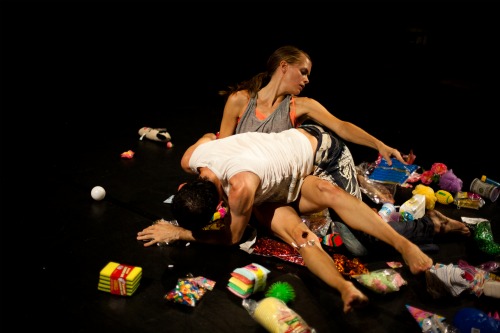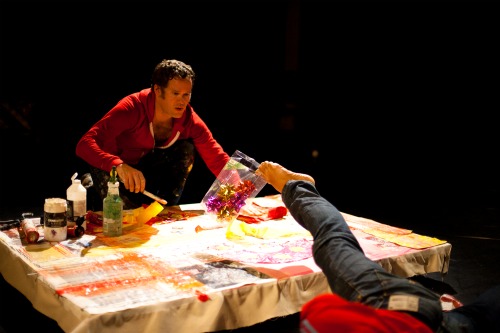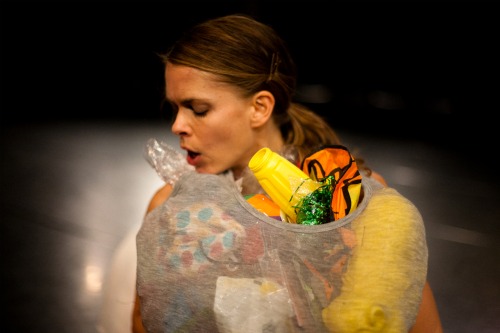“Where’d you get that? I must have one!” Must? Try “crave,” “desire.” And once you’ve acquired whatever it is, does your love of it grow or subside? When you take it out of the closet or down from the shelf after two years and realize that you haven’t used it or worn it for almost that long, do you get rid of it? Or do you fall in love all over again?
Mindless acquisition is the theme of Kimberly Bartosik’s I like penises: a little something in twenty-four acts—co-presented by the French Institute Alliance Française’s Crossing the Line Festival and Danspace, and performed at Saint Mark’s Church (September 12 through 14). Those generally likable body parts don’t even enter into the hoard-and-discard frenzy (luckily), although the title may have drawn some spectators new to Danspace performances.
There’s another, more hopeful theme in this new work by Bartosik: a resourceful and creative person can devise something beautiful and useful out of other people’s detritus. Also: wonderful dancing has a value beyond that of unwise purchases at the 99-cent store.
As in her Ecsteriority 1 & 2 (2008) and her 2010 The Materiality of Impermanence, Bartosik cleverly alters the performance space and the audience’s perspective, aided by Roderick Murray’s brilliant lighting. For i like penises, the spectators sit close to the action on three sides of an area that is, most of the time, awash in small household items and toys—most of them plastic and brightly colored. Marc Mann, Joanna Kotze, and Edmond Russo spend more time grabbing them and hurling them around than they do dancing, which is a pity, because these are marvelous performers.
Although all three get a chance to show off their distinctive ways of moving, it’s Mann’s opening solo that lodges in my memory. He dances big, then bigger—sweeping and spinning and bounding through the space. Rarely does he repeat a phrase. But his gestures can be subtle too, and he takes time with some of them. What keeps the choreography from being a display of offbeat prowess is Mann’s timing and focus. He looks as if he’s trying to figure something out, maybe to remember long-ago instructions. Is it only the fact that we’re in a church that makes him seem occasionally rapt?
He, Kotze, and Russo keep artist Jonathan Allen busy. When the show begins, Allen staples a large rectangle of canvas onto a low, wheeled platform. As he moves this around, obligingly pulling it out of the way when necessary, he acquires objects, many of them given to him by the dancers. These he glues to the canvas, working quickly, cutting up unmanageably shaped ones. At the end, the resultant collage is held up. Very handsome. (In case, you feel acquisitive yourself, the ones he makes at each performance are available: inquire of Amelia Abdullahsani, Lu Magus gallery: amelia@lumagnus.com).
At one point, Bartosik manages to embed Allen in his own creation. He and Kotze stand on it, locked in a kiss, while Mann, crouching to avoid Kotze’s decoratively positioned leg, slowly pushes the platform across the room.
What do the performers do with the objects? What don’t they do? They dump them out of huge, plaid, plastic bags of the kind ubiquitous on Broadway in the West 20s. They gather the things up and pack them back into the bags. They build small trash mountains and lay out trash trails. Talking a bit, occasionally singing (Mann), they exchange items they’re tired of by tossing them to each other. They lie down and wallow in them like hogs in mud. At one point, Russo hurls objects —one by one, faster and faster— at Mann, who manages to field a remarkable number of them.
In a later foraging operation, the three determinedly stuff things under their stretchy tee shirts. Pregnant with trash, they stagger around, trying to hoard just one more sponge, one more plastic ball. Kotze gets a copper scouring pad stuck between her toes but keeps shuffling along. This collector bulimia seems almost obscene, like something that should be done in private. Trying to nestle together, Russo and Kotze are kept apart by their protuberant chests, and in the piece’s most tender moment, he gently divests her of her stash. No wonder that when Mann dumps his loot right in front of busy Allen with his glue and brushes, Allen looks up and asks, “Are you okay?”
Amused and appalled, we spectators laugh, groan, wince. During one of the cleanups, a red object is accidentally left on the floor, not far from a little girl (disclosure: Bartosik and Murray’s daughter). She’s a bit worried. What will become of the stray object? Will it bother the dancers? Should she maybe pick it up, or. . .? One of the performers retrieves it, and she settles back and draws a relieved breath. It’s a lovely moment.
I realize that, in the end, the glut of stuff (including a trashy allusion to “So You Think You Can Dance”) overwhelms everything else—primarily the relationships among the performers and their high-value dancing. Maybe that’s the statement Bartosik wants to make, even as she puts the glut of objects to new uses (i.e. to entertain us and make us think); on the other hand, we already know that consumerism is rampant these days and that we’re drowning in disposables and bankrupting ourselves keeping up with the conspicuously wealthy. Allen is the hero in this: a human recycling center, St. Jonathan of the Town Dump.




Oh what lovely, funny writing, putting us in the audience with you, making us think, those of us who are three thousand miles away from this performance. “Pregnant with trash”–a perfect description of 2011 American culture. Thanks Deborah.
“awash in small household items and toys—most of them plastic and brightly colored.”
I’m always interested in seeing what people can do with Happy Meal toys!